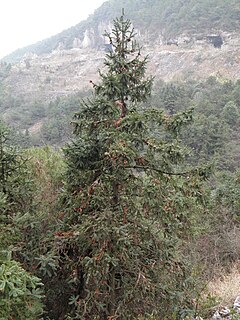
Cunninghamia is a genus of one or two living species of evergreen coniferous trees in the cypress family Cupressaceae. They are native to China, northern Vietnam and Laos, and perhaps also Cambodia. They may reach 50 m (160 ft) in height. In vernacular use, it is most often known as Cunninghamia, but is also sometimes called "China-fir". The genus name Cunninghamia honours Dr. James Cunningham, a British doctor who introduced this species into cultivation in 1702 and botanist Allan Cunningham.

John Day Fossil Beds National Monument is a U.S. national monument in Wheeler and Grant counties in east-central Oregon. Located within the John Day River basin and managed by the National Park Service, the park is known for its well-preserved layers of fossil plants and mammals that lived in the region between the late Eocene, about 45 million years ago, and the late Miocene, about 5 million years ago. The monument consists of three geographically separate units: Sheep Rock, Painted Hills, and Clarno.

Fossil Butte National Monument is a United States National Monument managed by the National Park Service, located 15 miles (24 km) west of Kemmerer, Wyoming, United States. It centers on an assemblage of Eocene Epoch animal and plant fossils associated with Fossil Lake—the smallest lake of the three great lakes which were then present in what are now Wyoming, Utah, and Colorado. The other two lakes were Lake Gosiute and Lake Uinta. Fossil Butte National Monument was established as a national monument on October 23, 1972.

Neurotrichus is a genus of shrew-like moles. It is classified, together with the fossil genus Quyania, in the tribe Neurotrichini of the subfamily Talpinae. The only living species is the American shrew-mole (N. gibbsii) of the northwestern United States and British Columbia. A fossil species, Neurotrichus columbianus from the Hemphillian of Oregon, was placed in the genus in 1968, but this animal is now thought to be more closely related to the Chinese fossil genus Yanshuella.

Bisonalveus is an extinct genus of shrew-like mammals that were presumably ground-dwelling and fed on plants and insects. Bisonalveus fossils have been discovered in the upper Great Plains region of North America, including sites in modern-day Wyoming, North Dakota, Montana, and Alberta. The fossils have been dated to 60 million years ago, during the Tiffanian North American Stage of the Palaeocene epoch. Bisonalveus is the last known genus of the Pentacodontinae sub-family to have arisen, replacing the genus Coriphagus in the early Tiffanian. Bisonalveus itself appears to have gone extinct by the middle Tiffanian.

Desmatophoca is an extinct genus of early pinniped that lived during the Miocene, and is named from the Greek "phoca", meaning seal. A taxon of the family Desmatophocidae, it shares some morphological similarities with modern true seals. Two species are recognized: Desmatophoca oregonensis and Desmatophoca brachycephala. Little information exists regarding Desmatophoca, due to the small number of fossil samples obtained and identified.

The John Day Formation is a series of rock strata exposed in the Picture Gorge district of the John Day River basin and elsewhere in north-central Oregon in the United States. The Picture Gorge exposure lies east of the Blue Mountain uplift, which cuts southwest–northeast through the Horse Heaven mining district northeast of Madras. Aside from the Picture Gorge district, which defines the type, the formation is visible on the surface in two other areas: another exposure is in the Warm Springs district west of the uplift, between it and the Cascade Range, and the third is along the south side of the Ochoco Mountains. All three exposures, consisting mainly of tuffaceous sediments and pyroclastic rock rich in silica, lie unconformably between the older rocks of the Clarno Formation below and Columbia River basalts above.
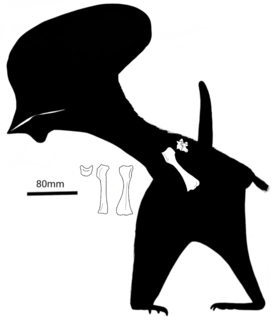
Bennettazhia is a genus of tapejaromorph pterosaur from the Early Cretaceous period of what is now the Hudspeth Formation of the state of Oregon in the United States. Although originally identified as a species of the pteranodontoid pterosaur Pteranodon, Bennettazhia is now thought to have been a different animal. The type and only species is B. oregonensis.

Somatochlora, or the striped emeralds, is a genus of dragonflies in the family Corduliidae with 42 described species found across the Northern Hemisphere.
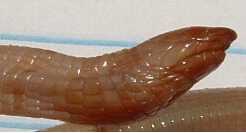
Rhineuridae is a family of amphisbaenians that includes one living genus and species, Rhineura floridana, as well as many extinct species belonging to both Rhineura and several extinct genera. The living R. floridana is found only in Georgia and Florida, but extinct species ranged across North America, some occurring as far west as Oregon. The family has a fossil record stretching back 60 million years to the Paleocene and was most diverse in the continental interior during the Eocene and Oligocene.
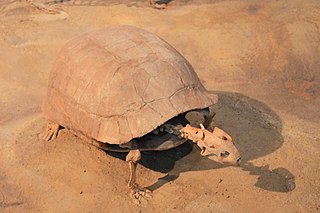
Stylemys is the first fossil genus of dry land tortoise belonging to the order Testudines discovered in the United States. The genus lived in temperate to subtropical areas of North America, Europe, and Asia, based on fossil distribution. The genus was first described in 1851 by Joseph Leidy. The tortoise was common in the prehistoric Badlands, especially Nebraska and South Dakota. The species has also been found in the formations in and around Badlands National Park. Fossil fragments have also been found in the Palm Park Formation of New Mexico.
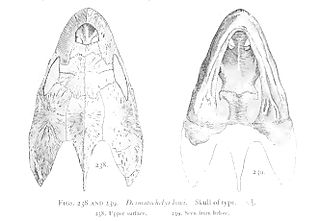
Desmatochelys is an extinct genus of sea turtles belonging to the family Protostegidae. This genus contains two known species, D. lowii and D. padillai. D. lowii was first discovered in 1895, followed by D. padillai in 2015. Having been estimated at over 120 million years old, D. padillai is currently the oldest known species of sea turtle.

Herpetotherium is an extinct genus of metatherian mammal, belonging to the possibly paraphyletic family Herpetotheriidae. Native to North America from the Eocene to Early Miocene, fossils have been found in California, Oregon, Texas, Florida, Montana, Wyoming, Colorado, North and South Dakota, Nebraska, and Saskatchewan. The oldest species, H. knighti, is dated to around 50.3 mya, and the most recent, an unnamed species, may be as recent as 15.97 mya. A morphological analysis of marsupials and basal metatherians conducted in 2007 found Herpetotherium to be the sister group to extant marsupials. It is the youngest known metatherian from North America until the migration of the Virginia opossum from South America within the last 2 million years.
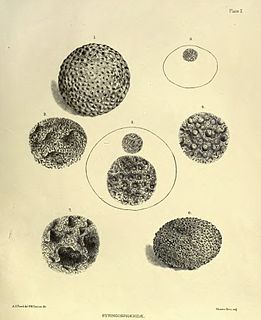
Heterastridium is an extinct genus of marine hydrozoan. It is the only accepted genus in the monotypic family Heterastridiidae. The fossils date from the Upper Triassic. They are mostly discoid or spherical and some forms found in the Karakorum mountains are called Karakorum stones. They vary in diameter from 1 to 35 cm and appear to follow Cope's rule for the prehistoric climate.

Laytonia is an extinct genus of prehistoric halosaur that lived in deep water off the North American Pacific Coast from the Zemorrian Epoch until during the Upper Miocene subepoch, when tectonic uplift effectively destroyed the genus' habitat by making the deep water too shallow.
Listrognathosuchus is an extinct genus of alligatoroid crocodilian. Fossils date back to the middle Paleocene epoch. In 1997, the generic name replaced that of Leidyosuchus for the species L. multidentatus. "L." multidentalis was first described by Charles Mook in 1930 on the basis of the holotype AMNH 5179, consisting of a partial vertebral column, mandible, partial left ilium, and left tibia, found from a locality in Torrejon Arroyo, New Mexico.

Fothergilla malloryi is an extinct species of flowering plant in the family Hamamelidaceae known from fossil leaves found in the early Eocene Klondike Mountain Formation deposits of northern Washington state. The F. malloryi leaves are the earliest appearance in the fossil record of a member of the witchalder genus Fothergilla, which includes the living species F. gardenii, and F. major, both of which are native to the southeastern United States. The genus also includes three or four other fossil species with two Asian Miocene species, F. viburnifolia from China, F. ryozenensis from Japan along with one Miocene North American species, F. praeolata of Oregon. Fothergilla durhamensis described from Eocene sediments in King County, Washington is considered dubious in placement, and it was transferred to the genus Platimeliphyllum by Huegele et al. (2021).

Paleontology in Oregon refers to paleontological research occurring within or conducted by people from the U.S. state of Oregon. Oregon's geologic record extends back approximately 400 million years ago to the Devonian period, before which time the state's landmass was likely submerged under water. Sediment records show that Oregon remained mostly submerged until the Paleocene period. The state's earliest fossil record includes plants, corals, and conodonts. Oregon was covered by seaways and volcanic islands during the Mesozoic era. Fossils from this period include marine plants, invertebrates, ichthyosaurs, pterosaurs, and traces such as invertebrate burrows. During the Cenozoic, Oregon's climate gradually cooled and eventually yielded the environments now found in the state. The era's fossils include marine and terrestrial plants, invertebrates, fish, amphibians, turtles, birds, mammals, and traces such as eggs and animal tracks.
Diplopora oregonensis is a species of algae in the genus Diplopora in the family Diploporaceae. It is a unique species of marine dasycladacean algae from the Triassic period. It was discovered by George Stanley of the University of Montana, with findings published in the 1980s. It was obtained from sands and shales of the Wallowa volcanic archipelago, more specifically the Hurwal Formation in eastern Oregon. The strata of this formation developed from geologic processing of limestone deposits. The deposits were produced along the floors of lagoons of an ancient shallow ocean.

















